Are you a business owner struggling to find truly sustainable packaging? It’s a tough spot to be in. You want to ditch plastic, but the alternatives can seem weak or just as harmful. Customers are demanding greener options, and the pressure is on to make a choice that is good for both your brand and the planet.
The primary environmental benefits of bamboo tableware are its rapid renewability and compostability. Bamboo grows incredibly fast and regenerates without replanting. When disposed of correctly in commercial composting facilities, it breaks down into organic matter, returning nutrients to the soil. This reduces landfill waste and reliance on fossil fuels used for plastic production, making it a key component of a circular economy.
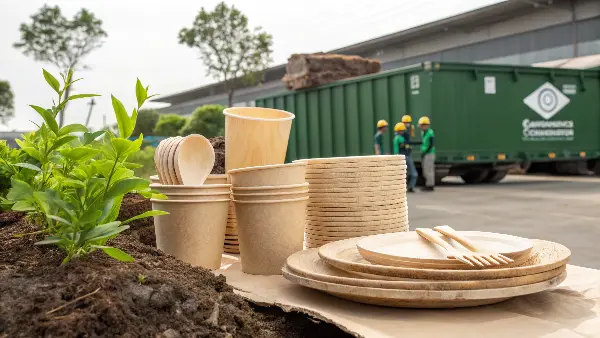
You’re probably thinking that sounds great, but how does it really compare to the disposables we’re so used to? It’s one thing to say a product is "eco-friendly," but as someone who deals with sourcing every day, I know the details matter. To really understand why bamboo is such a game-changer, we first need to look at the massive problem it’s trying to solve. Let’s break down the real impact of the disposable items we use every day.
What are the environmental impacts of disposable tableware?
Throwing away a plate or a fork after one use might seem like a small, harmless act. But when you multiply that by billions of people every year, it adds up to a global waste crisis. Plastic chokes our ecosystems, and even paper isn’t always the hero it seems to be. Understanding this full impact is the first step toward choosing smarter, greener solutions.
The biggest environmental impact comes from single-use plastics. They are made from non-renewable fossil fuels, a process that releases greenhouse gases. After a few minutes of use, they persist in landfills or oceans for hundreds of years, breaking down into harmful microplastics. Even paper products, if not from certified sustainable sources, can contribute to deforestation and often have plastic linings that prevent them from being recycled or composted properly.
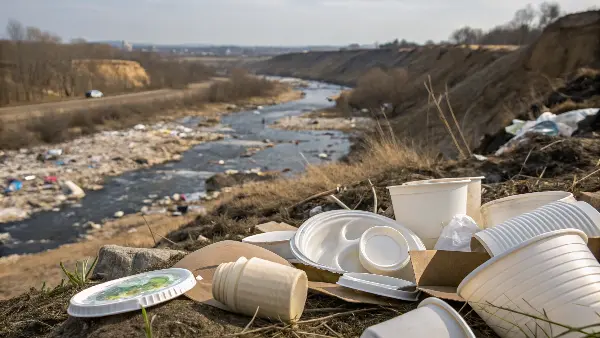
The Lifecycle of Disposables: From Creation to Waste
To really grasp the issue, you have to look at the entire journey of a disposable product. I’ve worked with countless clients who were shocked when they learned what really happens to the items they throw away. It’s not just about what happens after you’re done; it starts with how they’re made.
-
Single-Use Plastics (PET, PS): The journey begins with drilling for oil or natural gas. This extraction process itself is environmentally taxing. Then, these fossil fuels are refined and manufactured into plastic pellets in energy-intensive factories, releasing significant carbon emissions. After use, they become a permanent problem. They clog landfills for centuries and, if they escape into nature, they break down into microplastics that poison our water, soil, and wildlife.
-
Styrofoam (Polystyrene): This is one of the worst offenders. It’s bulky, lightweight, and breaks apart easily, making it a common source of litter. Like other plastics, it’s petroleum-based and never truly biodegrades. I remember visiting a recycling facility once and seeing mountains of so-called "recyclable" to-go containers being sent straight to landfill. The reality is, most facilities just can’t process it.
-
Conventional Paper Plates: Paper seems like a better choice, but it often hides a dirty secret. Many paper plates are coated with a thin layer of plastic or PFAS (so-called "forever chemicals") to make them waterproof and grease-resistant. This coating makes them impossible to recycle or compost, condemning them to the landfill. If they aren’t made from FSC-certified wood, their production also contributes to deforestation.
Here is a simple breakdown:
| Material | Source | Main Environmental Issue |
|---|---|---|
| Plastic | Fossil Fuels | Persists for 500+ years; microplastic pollution |
| Styrofoam | Fossil Fuels | Non-biodegradable; breaks into small, toxic pieces |
| Coated Paper | Trees | Plastic/PFAS lining prevents composting/recycling |
Understanding this stark reality is what drives us at Ecosourcecn to find and provide genuinely better alternatives.
Are bamboo plates better for the environment?
You need strong, reliable disposable plates for your business or a large event. But plastic is out of the question, and flimsy, coated paper plates just don’t cut it, often collapsing under a meal’s weight and ending up in the trash anyway. You need something that performs well and aligns with your green values. Bamboo plates offer a sturdy, elegant, and genuinely eco-friendly alternative.
Yes, bamboo plates are significantly better for the environment than plastic or conventional paper plates. They come from a highly renewable grass that matures in just 3-5 years and regenerates after harvesting without needing to be replanted. They are also 100% biodegradable and commercially compostable, breaking down into nutrient-rich soil instead of sitting in a landfill. This minimizes waste and promotes a true circular system.
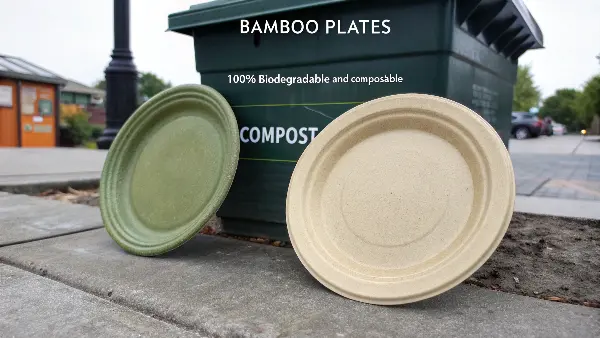
From Shoot to Plate: The Sustainability of Bamboo
The real beauty of bamboo lies in its natural life cycle. It’s not just "less bad" than plastic; it’s actively beneficial in many ways. For clients like Jacky in Canada who need to verify every environmental claim, these details are crucial.
First, let’s talk about the source. Bamboo isn’t a tree; it’s a type of grass. Certain species can grow up to three feet in a single day! It reaches full maturity in 3-5 years, compared to the 20-50 years it takes for pulp-wood trees. When it’s harvested, the root system remains intact, and new shoots sprout from it. This means no replanting is necessary, which prevents soil erosion and maintains the health of the ecosystem. It also requires very little water and no pesticides or fertilizers to grow.
The manufacturing process is also clean and straightforward. High-quality bamboo plates are made by layering strips of bamboo and bonding them with heat and pressure. At Ecosourcecn, we ensure our suppliers use no chemical bleaches, dyes, or synthetic binders. The result is a product that is pure, natural, and food-safe.
The end-of-life story is where bamboo truly shines. Certified compostable bamboo plates (look for EN13432 or BPI certification) can break down in a commercial composting facility in about 180 days. They return to the earth as humus, a nutrient-rich organic matter that improves soil health. This closes the loop, turning "waste" into a valuable resource, which is the ultimate goal of a circular economy.
Are bamboo utensils good for the environment?
Every takeout order or food truck meal usually comes with a plastic fork, knife, and spoon. These tiny items are a massive source of pollution. They are too small to be sorted by most recycling machinery and they frequently end up littering our communities, parks, and waterways. Bamboo utensils provide a simple, direct swap that eliminates this plastic waste with every single meal served.
Absolutely. Bamboo utensils are an excellent environmental choice. Just like bamboo plates, they are made from a fast-growing, renewable resource that requires no pesticides. They are lightweight yet impressively strong, completely biodegradable, and can be composted in commercial facilities. By replacing single-use plastic cutlery, they directly reduce our reliance on fossil fuels and prevent long-term plastic pollution from ever being created.
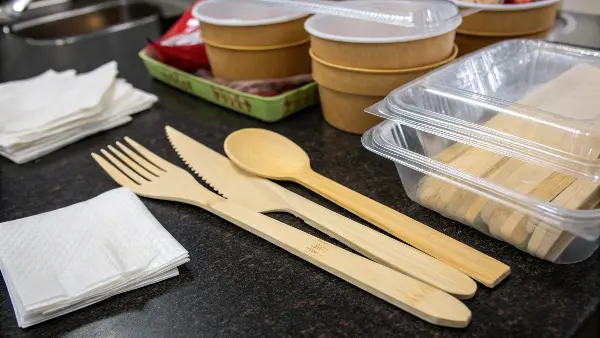
A Stronger Choice: Why Bamboo Cutlery Works
When I talk to food service businesses, performance is just as important as sustainability. No one wants to give their customers a fork that snaps in a salad or a spoon that feels like a splintery piece of wood. This is where bamboo cutlery proves its worth beyond simply being "green."
One of the first things people notice is its strength. Bamboo has a higher tensile strength than many types of steel, so these utensils don’t bend or break under pressure like flimsy plastic ones do. They can easily handle tough foods, hot liquids, and dense salads. I’ve worked with many cafes that switched to our bamboo cutlery. They told me the biggest surprise was a sudden drop in complaints about broken forks. It’s a small detail, but it makes a huge difference in customer experience.
Another concern I often hear is about taste or texture. Low-quality wooden utensils can sometimes impart a "woody" flavor to food and have a rough, unpleasant mouthfeel. High-quality bamboo, on the other hand, is sanded to a smooth finish and is naturally tasteless and odorless. It provides a much more pleasant eating experience.
Finally, let’s circle back to its end-of-life. These utensils are designed to break down. In a commercial compost environment, they will decompose efficiently, leaving no toxic residue behind. They offer all the convenience of a disposable with none of the centuries-long guilt of plastic. It’s a practical, powerful, and positive change any business can make.
Which disposable plates are best for the environment?
Navigating the world of eco-friendly disposables can be confusing. You see terms like bagasse, PLA, recycled paper, and bamboo, but what’s the real difference between them? Making the wrong choice can mean you’re not as green as you think you are, or you end up sacrificing performance for a "green" label that doesn’t hold up. Let’s compare the top contenders to find the best choice for your specific needs.
The "best" disposable plate depends on your specific needs, but bamboo and bagasse (sugarcane fiber) are often the top environmental performers. Both are made from rapidly renewable resources and are fully commercially compostable. Bamboo excels in strength and offers a premium, natural aesthetic. Bagasse is excellent for hot and oily foods and cleverly repurposes a waste byproduct of the sugar industry. Both are far superior to plastic, styrofoam, and non-certified paper products with plastic coatings.
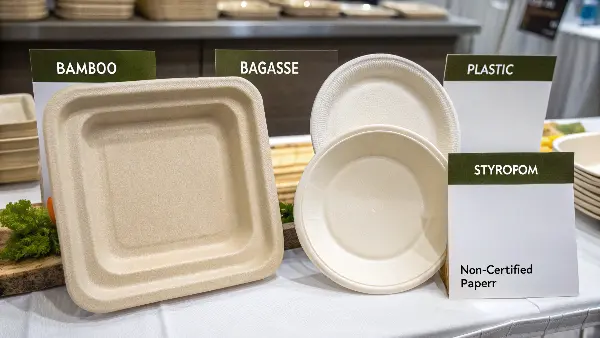
Comparing the Green Contenders: Bamboo vs. The Rest
As a packaging specialist, Jacky needs to know the pros and cons of every material to make the right call for his brand. There is no single "perfect" solution for everyone; the best choice depends on the application, budget, and branding. Here’s a clear comparison to help you decide.
| Material | Source | Key Benefit | Main Drawback | Best For |
|---|---|---|---|---|
| Bamboo | Bamboo Grass | Very strong, rigid, and has a beautiful natural look. Made from a rapidly renewable resource. | Can be more expensive than other options. | Premium events, sturdy meals, branding that emphasizes natural elegance. |
| Bagasse | Sugarcane Pulp | Excellent with hot, wet, or oily foods. Made from a reclaimed agricultural waste product. | Can be softer and more fibrous than bamboo. | Hot food to-go containers, bowls, and general-purpose plates. |
| PLA (Polylactic Acid) | Corn Starch | Can be molded into clear, plastic-like forms (e.g., cold cups). Compostable. | Needs specific industrial composting conditions; can be brittle. Mistaken for plastic. | Cold drinks, dessert containers, and cutlery where a plastic-like feel is desired. |
| Recycled Paper | Post-Consumer Paper | Diverts paper from landfills and reduces the need to cut down new trees. | Often gets soggy; many are still lined with plastic or PFAS, making them non-compostable. | Dry foods like sandwiches or pizza, but only if you can verify it’s uncoated. |
Ultimately, both bamboo and bagasse stand out as superstar materials. They come from renewable, non-food sources (bamboo is a grass, bagasse is waste) and return to the earth cleanly. PLA is a good option but requires educating the end-user on proper disposal, as it will not break down in a landfill. My advice is always to match the material to the use case. For a strong, visually appealing plate that speaks to quality and nature, bamboo is an unmatched choice.
Conclusion
Choosing bamboo tableware is more than a safety decision; it’s a powerful environmental statement. By opting for a product that comes from a fast-growing plant and returns to the earth as soil, you actively reduce landfill waste and plastic pollution. It’s a simple switch with a significant, positive impact for your business and the planet.


